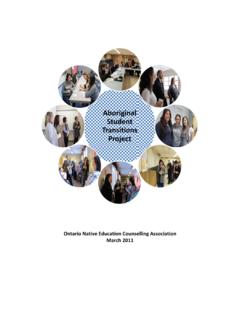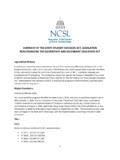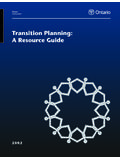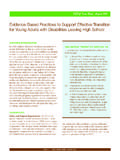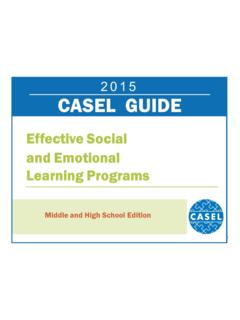Transcription of Student Involvement/Engagement in Higher …
1 Research in Higher education Journal Student Involvement/Engagement in Higher education Based on Student Origin Jalynn Roberts. University of Southern Mississippi Mary Nell McNeese University of Southern Mississippi Abstract This research study investigated Student Involvement/Engagement based on educational origin. The 190 students in the sample graduated with bachelors' degrees from a public university in the southeastern United States in either 2006 or 2007. Results of the data analysis showed that students were involved/engaged at their university on statistically different levels based on their educational origin.
2 Indigenous students were different from the transfer students but the transfer students were the same regardless from where they originated. The indigenous students were the most involved, followed by transfers from junior/community colleges. Transfer students from four-year colleges and universities were the least involved/engaged. Keywords: post-secondary education , Student Involvement/Engagement , Student retention, Student persistence Student Involvement/Engagement , Page 1. Research in Higher education Journal Introduction All across our country, colleges and universities face an ever-increasing problem of Student attrition.
3 The typical six-year graduation rate for most public institutions in the United States ranges between 50 56 % (Mortenson, 2005; Crosling, Thomas, and Heagney, 2008; and Berkner, He, and Cataldi, 2002). However, the Higher education Research Institute (HERI). found the national six-year graduation rate for public universities to be slightly Higher , at 58%. (Astin & Oseguera, 2002). What is interesting about these statistics is that nearly half of all undergraduate students who enter public universities will not graduate within six years. Although institutions have responded to this quandary by implementing additional programs and services, Student retention rates have not substantially improved (Seidman, 2005a).
4 Mary Stuart Hunter (2006), Director of Administration at the National Resource Center for the First-Year Experience and students in Transition at the University of South Carolina . Columbia, contends, Institutions in all sectors of Higher education are attempting to increase Student success by focusing on Student retention (p. 5). This retention problem affects both the students and the institutions they leave who feel the added economic burden caused by their premature departures. Indeed, the impact of Student attrition extends beyond institutions of Higher learning to the nation itself. Seidman (2005a) explains, A strong, vibrant, varied, and expanding national economy depends in part on the educational attainment of its citizens.
5 A nation that values and promotes the educational attainment of its citizens is a nation that is concerned with its ability to compete in the global economy. (p. xi). Retention is a campus-based phenomenon, and different types of campuses tend to attract different types of students (Berger & Lyon, 2005). According to Astin (1990), retention rates vary by campus due to the differences in the types of students attracted and recruited by certain schools, and it is imperative that institutions provide an environment and climate that fit well with their particular Student populations. Therefore, it is the responsibility of particular colleges and universities to graduate the students who enroll at their institutions, and each institution must tailor retention to fit the specific needs of its students and the context of that particular institutional environment (Berger & Lyon, 2005, p.)
6 3). Based on this premise the university, that is the focus of this study, developed an avenue of communication with its former students to obtain feedback specific to that institution. While the literature on Student retention focuses on at least four key contributing factors: Student Involvement/Engagement ; Student interactions with faculty, administrators, and staff;. Student learning experiences; and Student support services, the present study will focus solely on Student Involvement/Engagement . Student Involvement/Engagement Several theories have emerged over the last several decades explaining the relationship between Student retention and involvement .
7 Much research by Astin revolves around the impact of Student involvement on Student outcomes in college, and his essential assertion is that students must be actively engaged in their surroundings in order to learn and grow in college (Evans, Forney, and Guido-DiBrito, 1998). Astin (1984) defines involvement as the amount of physical and psychological energy that the Student devotes to the academic experience (p. 297). Student Involvement/Engagement , Page 2. Research in Higher education Journal Schlossberg's theory on marginality and mattering is also an important concept recognized in college Student success (Evans et al.)
8 , 1998). According to Schlossberg, students feel marginalized when they feel as if they do not fit it in, which leads to negative outcomes such as self-consciousness, irritability, and depression (Evans et al., 1998, p. 27). Feeling marginalized causes students to wonder if they matter to someone else (Schlossberg, 1989, p. 9). Schlossberg emphasizes the imperative that post-secondary institutions make students feel significant since that feeling precedes Student involvement in college activities and programs. The first step to becoming engaged and involved on college campuses is for students to interact with their peers.
9 According to Schlossberg's theory, Student -peer interaction is imperative if participating in campus activities and Student organizations is to be meaningful. These interactions reinforce academic learning and also permeate into other areas of college life such as discussing policies and issues related to campus activities; having serious discussions about religious, philosophical, or political beliefs; discussing personal problems; discussing the arts, science, technology, or international relations; and talking about an idea brought up in class (Pascarella & Terenzini, 2005, p. 121). While it is true that students must experience academic success to remain in college, it is also vital that they become involved and engaged in other areas of college life.
10 In fact, Gerdes and Mallinckrodt (1994) state that personal adjustment and integration into the social fabric of campus life plays a role at least as important as academic factors in Student retention (p. 286). From this research, it seems evident that students must become engaged in experiences which promote both academic and social reinforcement. According to Tinto (1993), however, it is entirely possible for individuals to achieve integration in the academic system of the college without doing so in the social domain (p. 120). Additionally, Tinto found that students who do not become socially integrated may or may not suffer from persistence issues, depending on the individual.












